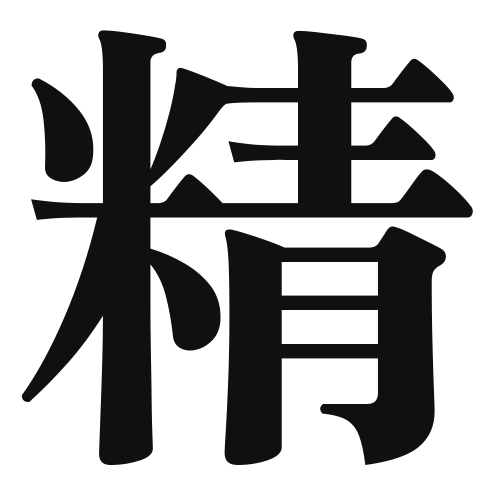1. Overview of Meaning
The kanji “精” (sei) generally means “refinement,” “spirit,” or “essence.” It conveys the idea of purity and high quality, often associated with meticulousness and attention to detail.
2. Formation and Radical
Formation of the Kanji: The kanji “精” is a phonetic-ideographic character (形声文字), which combines a meaning component and a sound component. The left part, “米” (rice), suggests something pure and essential, while the right part, “青” (blue/green), indicates a phonetic element.
Radical: The radical of “精” is “米,” which relates to rice, symbolizing nourishment and purity.
3. Examples of Usage
Common Words and Phrases: Some frequently used words that include “精” are:
- 精密 (seimitsu) – precision
- 精神 (seishin) – spirit or mind
- 精華 (seika) – essence or extract
Example Sentences in Daily Conversation:
- この機械は非常に精密です。 (Kono kikai wa hijō ni seimitsu desu.) – This machine is very precise.
- 彼の精神は強いです。 (Kare no seishin wa tsuyoi desu.) – His spirit is strong.
4. Synonyms and Antonyms
Similar Kanji: A kanji with a similar meaning is “純” (jun), which means “pure.” While both convey a sense of purity, “精” often emphasizes refinement and quality, whereas “純” focuses more on the idea of being untainted or genuine.
Opposite Kanji: An antonym is “粗” (so), which means “rough” or “coarse.” This contrasts with “精,” as it implies a lack of refinement or quality.
5. Cultural and Historical Background
Relation to Japanese Culture: The concept of “精” is deeply embedded in Japanese culture, often associated with craftsmanship and the pursuit of perfection in various arts, such as tea ceremony and calligraphy.
Proverbs and Idioms: One common saying is “精一杯” (seiippai), which means “to do one’s best” or “to the best of one’s ability,” reflecting the cultural value placed on effort and dedication.
